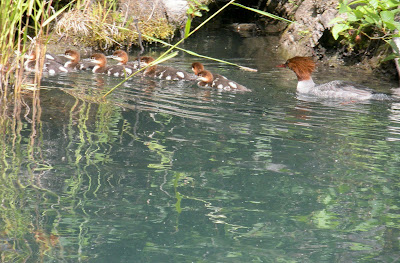
Autumn just might be the best time to experience nature on the North Olympic Peninsula.
The record low water levels in our rivers provide an abundant opportunity to observe many rare and colorful species of birds, animals and fish as they struggle to survive in a drought-stricken wilderness.
With each passing day the rivers drop lower, forcing the creatures of the rainforest to gather closer about the shrunken remains of what was once a majestic river.
The fish are the first to suffer. Baby salmon are trying to migrate out to sea. The adult salmon are waiting out in the ocean to come up the river.
The salmon are being mercilessly decimated in the low, clear water by the myriad predators who must feed heavily to put on fat before the first snow of winter. Some of these predators fish in a cooperative manner that increases their success and passes on fishing skills to a younger generation.
For example, the Belted Kingfisher is an almost crow-sized bird with a beak too big for its head and a head too big for its body. The Kingfisher has a call that sounds like someone shaking a can of rocks and an annoying habit of hovering in the air in a manner totally against the laws of science.
Once the Kingfisher spots a fish, it dives into the water and spears it, then erupts from the surface like a feathered missile.
I recently watched a Kingfisher hover in one place for almost a minute. This must be some sort of record if there is such a thing for Kingfisher hovering. There was a family of common mergansers. These are sawbilled fish ducks, strung out in a line swimming up the river. They were pushing fish to the Kingfisher who dropped like a rock with a big splash not 20 feet in front of the fish ducks.
The mergansers dove to catch the fish that the splash of the Kingfisher had spooked back to them. I have observed many variations of this enlightened fishing behavior among bears, herons, otters, ravens, crows and eagles, sea lions and seals.
Other predators require solitude to pursue their prey with a more individual fishing technique. Every year many types of human predators migrate to the Olympic Peninsula from every corner of the globe to fish in the solitude of the rain forest.
It is during periods of low water that these shy creatures are forced to converge on the lower portions of the river where the overcrowding produces an aberrant fishing behavior that is amusing to watch.
The twinkle toed fly fisherman is an ornery critter that needs a lot of room to fish because of their habit of whipping a steel tipped length of line about their heads in an attempt to fling it out into the river.
The long leadered flosser is another odd bird. They are trying to cast a piece of fishing line through the teeth of a racing fish that may have been spooked upstream by the hardware tossing spinner fisherman. Who is trying to hook a fish in the mouth without snagging it in the dorsal fin and being branded a brazen snagger.
That is a morally corrupt species who attempt to snag a fish with big hooks. They are only one evolutionary step above the common gaffer, a rare predator who get their fish out of the river with a gaff hook.
All of these species have one thing in common. They want to ban the other guy's gear.
Fortunately, the rains have returned. The salmon are running upstream. The predators will disperse into the uppermost reaches of the rain-swollen watershed where I will miss them.


No comments:
Post a Comment